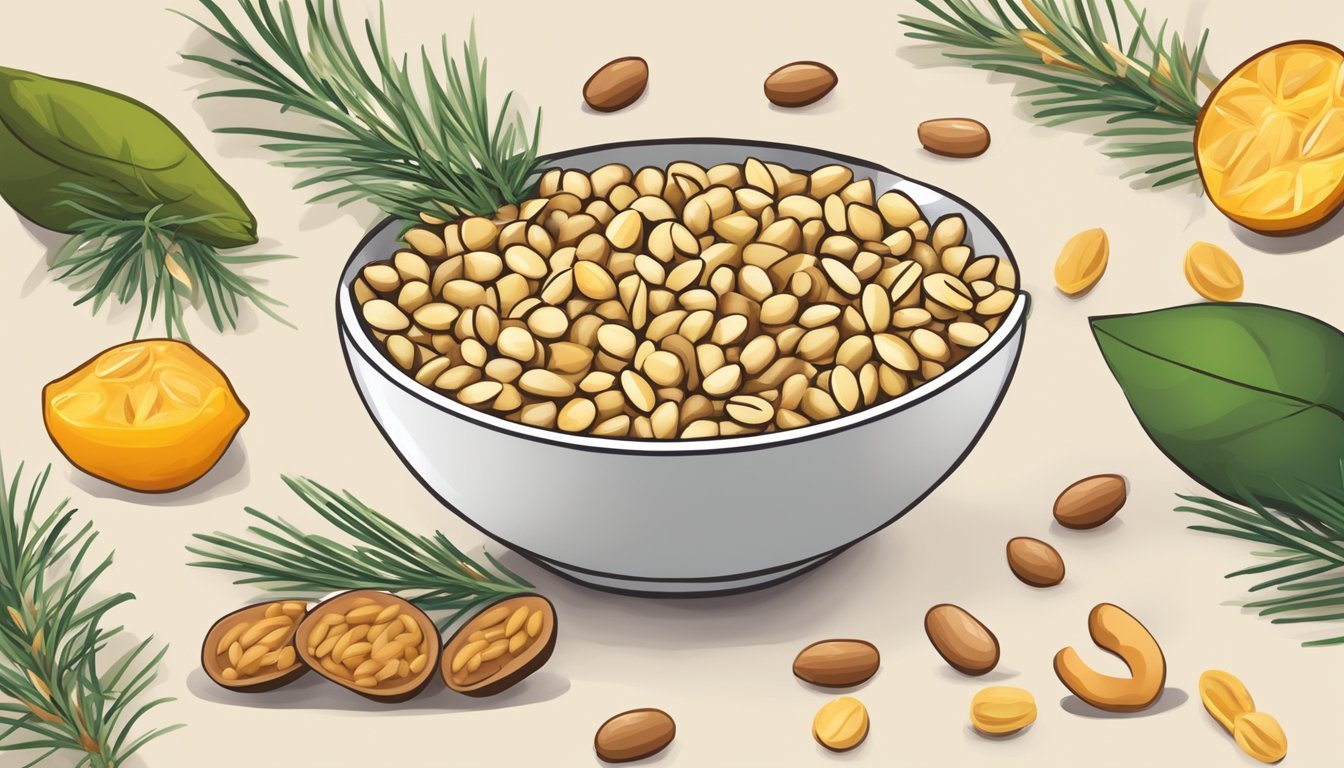Common Foods High in Omega-6 to Limit in Your Diet
Protect Your Health
In the pursuit of a healthier lifestyle, understanding the role of omega-6 fatty acids in your diet is crucial. While these essential fats are vital for various bodily functions, an excessive intake, especially from certain sources, can lead to health issues.
There are specific foods high in omega-6 that individuals should limit or avoid to maintain an optimal balance of fatty acids in their diet. This article explores those foods and provides insights on how to manage omega-6 consumption effectively.
1) Corn Oil
Corn oil is frequently used in cooking due to its high smoke point and neutral flavor. However, it is rich in omega-6 fatty acids, primarily linoleic acid.
Excessive consumption of corn oil can lead to an unhealthy ratio of omega-6 to omega-3 fatty acids. This imbalance may contribute to inflammation.
Corn oil's omega-6 to omega-3 ratio is approximately 50:1. For a healthier alternative, consider using oils with a more balanced fatty acid profile, such as olive oil.
Many processed foods and snacks contain corn oil, so it's essential to read ingredient labels. This can help in reducing undue intake of omega-6 fats.
2) Soybean Oil
Soybean oil is common in many households and commercial kitchens. It is often used in cooking, baking, and processed foods. This oil is derived from soybeans and is known for its high omega-6 fatty acid content.
Consumers should be aware that excessive intake of omega-6 fatty acids can disrupt the balance between omega-6 and omega-3 in the body. This imbalance may contribute to inflammation and other health issues.
Soybean oil is often found in items such as margarine, salad dressings, and various snack foods. People aiming to reduce their omega-6 intake should consider limiting their use of these products.
There are many healthier alternatives to soybean oil, such as olive oil, which has a more favorable fatty acid profile. Switching to these alternatives can help maintain a better balance of essential fatty acids.
Reading ingredient labels can help identify processed foods that contain soybean oil, making it easier to avoid high omega-6 intake.
3) Mayonnaise
Mayonnaise, a common condiment, is often high in omega-6 fatty acids. Made primarily from soybean oil, canola oil, or vegetable oil, it can contribute significantly to the intake of omega-6.
Commercial mayonnaise usually contains additional ingredients that are not nutritionally beneficial. These can include added sugars, artificial colors, and preservatives.
Balancing omega-6 intake with omega-3 fatty acids is crucial for maintaining health. Though mayonnaise can enhance the flavor of many dishes, its consumption should be moderate.
Alternatives such as avocado mayo or homemade versions using healthier oil options may help reduce omega-6 intake while still providing a creamy texture.
4) Walnut Oil
Walnut oil is known for its high omega-6 fatty acid content. While omega-6 is essential for the body, excessive intake can lead to an imbalance, especially if omega-3 intake is low.
Each tablespoon of walnut oil contains a significant amount of omega-6, making it a concentrated source.
Due to its high omega-6 content, it is advisable to use walnut oil sparingly. A small amount can be beneficial, but overuse should be avoided.
Those who already consume plenty of omega-6 from other sources should be particularly cautious. Moderation is key to maintaining a balanced diet.
For individuals allergic to walnuts or related nuts, walnut oil should be completely avoided. Seek alternative oils to prevent allergic reactions.
5) Sunflower Seeds
Sunflower seeds are a common snack and an ingredient in many dishes. They are rich in omega-6 fatty acids, which are essential fats needed for overall health. However, consuming excessive amounts can lead to an imbalance between omega-6 and omega-3 fatty acids.
A diet too high in omega-6 fatty acids and low in omega-3s can contribute to inflammation and increase the risk of certain diseases. This is because omega-6 fatty acids promote inflammatory processes in the body when not balanced with omega-3 intake.
Sunflower seeds are also high in calories and can be easy to overconsume. It is important to moderate intake to avoid potential health issues.
Choosing to eat sunflower seeds in moderation and balancing them with foods high in omega-3 fatty acids, such as fish or flaxseeds, can help maintain a healthier diet.
6) Peanut Butter
Peanut butter contains a high amount of omega-6 fatty acids. While omega-6 is essential for the body, an excess can lead to an imbalanced omega-6 to omega-3 ratio. This imbalance is linked to inflammation and several chronic conditions.
Peanut butter is also rich in protein and healthy fats. It lowers bad (LDL) cholesterol and increases good (HDL) cholesterol. It offers a host of other nutrients like arginine, an amino acid beneficial for heart health.
However, moderation and balance are key. Those who consume peanut butter regularly should ensure they are also getting enough omega-3 rich foods. This can help maintain the ideal ratio of these fatty acids for optimal health.
7) Chicken Thigh
Chicken thigh is a popular food choice due to its rich flavor and tenderness, but it also contains high levels of omega-6 fatty acids.
Especially when roasted, chicken thigh can provide around 22% of the daily recommended intake of omega-6, which is significantly higher than leaner cuts of chicken, such as chicken breast.
The omega-6 content in chicken thigh is primarily found in the dark meat and the skin. This can contribute to an imbalance in the omega-3 to omega-6 ratio if consumed in excess.
Reducing the intake of chicken thighs and opting for leaner cuts or other protein sources can help maintain a balanced diet. It's important to consider both the type and preparation of chicken when managing omega-6 consumption.
Choosing skinless chicken breast or other lean meats provides a healthier alternative with lower omega-6 levels.
8) Pine nuts
Pine nuts are small, edible seeds from pine trees. They are commonly used in various cuisines due to their rich, buttery flavor. While nutritious, pine nuts are also high in omega-6 fatty acids.
Excessive consumption of omega-6 can contribute to inflammation if not balanced with omega-3 intake. A serving of pine nuts contains a significant amount of omega-6, making it important to consume them in moderation.
Incorporating pine nuts into dishes should be done thoughtfully. They can be enjoyed as part of a balanced diet, but overindulgence may negate their benefits. Choosing other nuts with lower omega-6 content can help manage overall fatty acid intake.
Diversifying sources of healthy fats is critical. While pine nuts offer essential nutrients, relying on them heavily without considering their omega-6 content could lead to an imbalance.
9) Processed cheese
Processed cheese is a common food item that contains high levels of omega-6 fatty acids. This type of cheese is often made using a blend of natural cheese and other ingredients like emulsifiers, preservatives, and additional fats. The combination enhances its texture and shelf life, making it a convenient, though less healthy, option.
High in saturated fats, processed cheese can contribute to elevated cholesterol levels. This might increase the risk of heart disease over time. Additionally, the high sodium content in processed cheese can lead to high blood pressure, adding another layer of health concerns.
Unlike natural cheeses, processed cheese lacks many of the beneficial nutrients found in whole, unprocessed cheese. It is essential to consider these nutritional deficiencies when evaluating the overall impact of processed cheese on one's diet.
Opting for natural or low-fat cheese alternatives can be a smarter choice for those looking to balance their omega-6 intake. Reducing consumption of processed cheese can help in maintaining better overall health and managing omega-6 levels.
10) Almonds
Almonds are a popular snack known for their nutritional benefits. However, they are relatively high in omega-6 fatty acids. One ounce of almonds contains approximately 3.5 grams of omega-6. While almonds offer other essential nutrients, such as vitamin E and magnesium, their omega-6 content may be a concern for those looking to limit their intake.
Balancing the consumption of almonds with other foods rich in omega-3 fatty acids can help maintain a healthier dietary balance. It's important to consider portion sizes and overall diet composition. Almonds can be enjoyed in moderation as part of a balanced diet without significantly impacting omega-6 intake.
For those seeking to reduce omega-6 consumption, substituting almonds with lower omega-6 nuts or seeds may be beneficial. Always consider the whole nutritional profile of foods to make informed dietary choices.
Health Impacts of High Omega-6 Intake
Excessive consumption of omega-6 fatty acids can lead to various health issues, including inflammation and disruption of the optimal balance between omega-6 and omega-3 fatty acids. Maintaining the right balance is crucial for preventing chronic diseases and promoting overall health.
Inflammation and Chronic Diseases
High intake of omega-6 fatty acids is linked to increased inflammation in the body. Inflammation is a natural response, but chronic inflammation can lead to various health issues.
Studies suggest that an imbalance between omega-6 and omega-3 fatty acids may contribute to the development of chronic diseases. Conditions like cardiovascular disease, type 2 diabetes, and arthritis have been associated with excessive inflammation. It is important to manage omega-6 intake to reduce the risk of these illnesses.
Impaired Omega-3 to Omega-6 Ratio
The ratio of omega-3 to omega-6 fatty acids in the diet is crucial for health. A high omega-6 intake can impair this ratio, diminishing the beneficial effects of omega-3 fatty acids.
Omega-3 fatty acids are known for their anti-inflammatory properties and their role in supporting heart health. When omega-6 fats dominate the diet, the balance shifts, potentially compromising the health benefits provided by omega-3s. Achieving a balanced ratio can support overall health and help prevent inflammation-related diseases.
Alternatives to High Omega-6 Foods
It is important to find suitable replacements for foods high in omega-6 to maintain a healthier diet. This section highlights specific changes you can make and provides practical tips for balancing your intake of omega-3 and omega-6.
Incorporating Omega-3 Rich Foods
Adding omega-3 rich foods to your meals can help balance your fatty acid intake. Fish such as salmon, mackerel, and sardines are excellent sources.
Nuts and seeds: Flaxseeds and chia seeds are high in omega-3s. Consider adding them to smoothies or salads.
Vegetarian options: For those who prefer plant-based foods, algae oil supplements provide significant omega-3 content.
Daily choices: Opt for snacks like walnuts, which also supply beneficial omega-3s.
These substitutions can aid in reducing inflammation and supporting heart health.
Balanced Diet Tips
Strive to maintain a balance between omega-3 and omega-6 fats. Avoid vegetable oils like sunflower and corn oil, which are high in omega-6.
Cook with: Use olive oil or avocado oil instead. Replace processed snacks with whole foods. For instance, swap chips for fruit or yogurt.
Variety is key: Incorporate a diverse range of foods to ensure comprehensive nutrition. Fresh vegetables, lean proteins, and whole grains are fundamental.
Meal planning: Preparing meals ahead of time can help manage omega-6 intake. Make a list of omega-3 rich ingredients and ensure they are included in your weekly diet.
These tips contribute to a more balanced and healthier eating pattern.
Understanding Omega-6 Fatty Acids
Omega-6 fatty acids play a crucial role in the body, contributing to cellular functions and overall health. It's important to be aware of their sources and maintain balanced dietary intake to avoid potential health issues.
Role in the Body
Omega-6 fatty acids are essential polyunsaturated fats that the body can't produce on its own. They are involved in various bodily functions, including growth and development, brain function, and maintaining bone health.
They also help regulate metabolism and inflammation response. An adequate intake contributes to overall cell function and offers protective benefits against some diseases. Regulation of inflammation is one such crucial benefit, though excess intake can shift this balance unfavorably.
Sources and Dietary Recommendations
Common sources of omega-6 fatty acids include vegetable oils, such as corn oil, soybean oil, and sunflower oil. Additionally, nuts and seeds, like walnuts and sunflower seeds, are rich in omega-6.
Animal products, particularly those from poultry like chicken thighs, also contain notable amounts. It's advised to balance these with omega-3 intake to optimize health benefits.
Health organizations typically recommend omega-6 to make up about 5-10% of daily caloric intake, translating to 12-22 grams daily for most adults. Adjusting intake of omega-6-rich foods while ensuring a good mix of omega-3s is key to maintaining a healthy diet.











